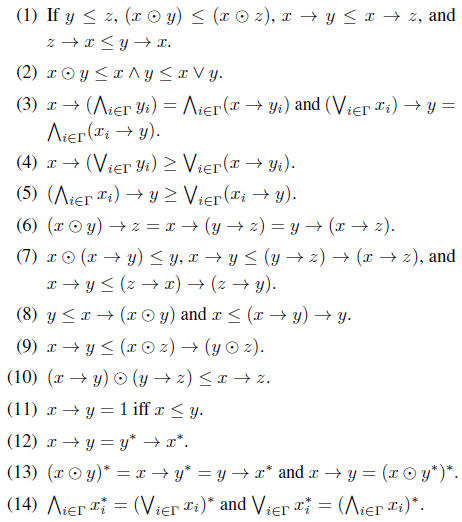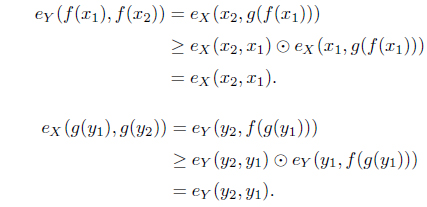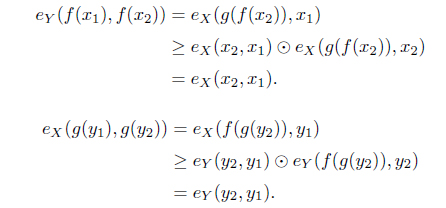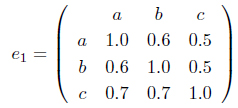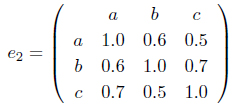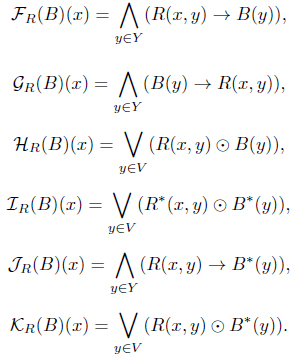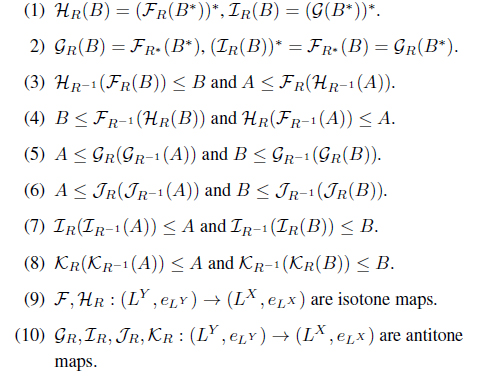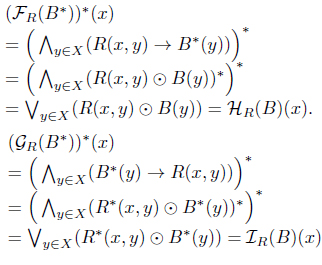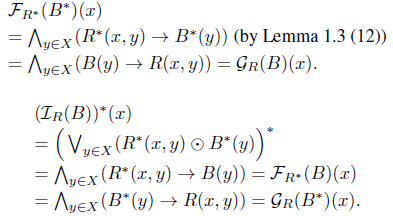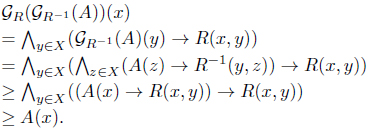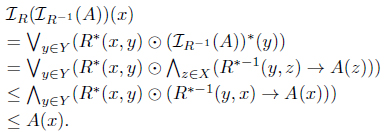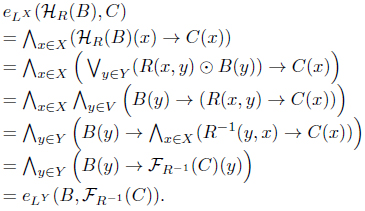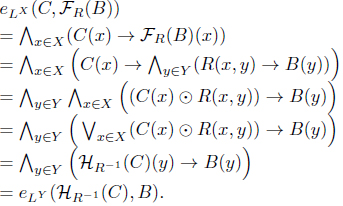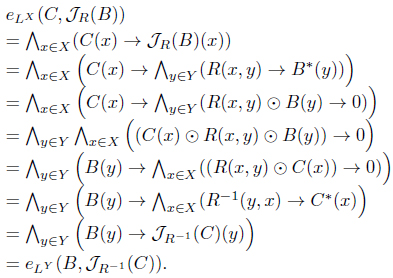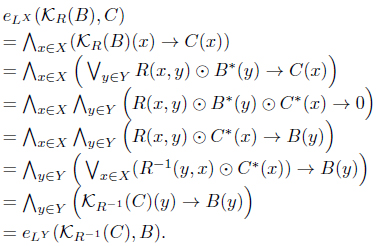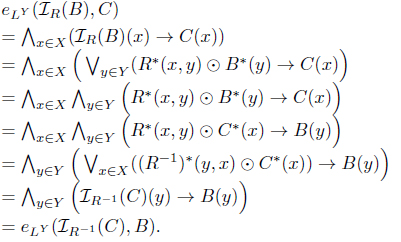



A Galois connection is an important mathematical tool for algebraic structure, data analysis, and knowledge processing [1-10]. Hájek [11] introduced a complete residuated lattice
In this paper, we investigate properties of fuzzy Galois (dual Galois, residuated, and dual residuated) connections in
Definition 1.1. [11, 12] An algebra is called a complete residuated lattice if it satisfies the following conditions:
(C1) is a complete lattice with the greatest element 1 and the least element 0; (C2) (L, , 1) is a commutative monoid; (C3) x y ≤ z iff x ≤ y → z for x, y, z ∈ L.
Remark 1.2. [11, 12] (1) A completely distributive lattice is a complete residuated lattice defined by
In particular, the unit interval is a complete residuated lattice defined by
(2) The unit interval with a left-continuous t-norm , , is a complete residuated lattice defined by
In this paper, we assume that is a complete residuated lattice with the law of double negation, i.e.,
Lemma 1.3. [12] For each
Definition 1.4. [4, 7] Let
(E1) reflexive if eX(x, x) = 1 for all x ∈ X, (E2) transitive if eX(x, y) eX(y, z) ≤ eX(x, z), for all x, y, z ∈ X, and (E3) if eX(x, y) = eX(y, x) = 1, then x = y.
If
Example 1.5. (1) We define a function
as
Then, (
(2) If (
2. Fuzzy Connections and Relations in Complete Residuated Lattices
Definition 2.1. Let (
(1) (
eY(y, f(x)) = eX(x, g(y)).
(2) (
eY(f(x), y) = eX(g(y), x).
(3) (
eY(f(x), y) = eX(x, g(y)).
(4) (
eY(y, f(x)) = eX(g(y), x).
(5)
(6)
(7)
If
Remark 2.2. Let (
(1) (eX, f, g, eY) is a Galois (resp. dual Galois) connection iff (eY, g, f, eX) is a Galois (resp. dual Galois) connection. (2) (eX, f, g, eY) is a Galois (resp. residuated) connection iff (, f, g, ) is a dual (resp. dual residuated) Galois connection. (3) (eX, f, g, eY ) is a residuated (resp. dual residuated) connection iff (, g, f, ) is a residuated (resp. dual residuated) connection. (4) (eX, f, g, eY) is a Galois (resp. dual Galois) connection iff (eX, f, g, ) is a residuated (resp. dual residuated) connection. (5) (eX, f, g, eY) is a residuated connection iff (eY, g, f, eX) is a dual residuated connection.
Theorem 2.3. Let (
(1) (eX, f, g, eY) is a Galois connection if f, g are antitone maps and eY(y, f(g(y))) = eX(x, g(f(x))) = 1. (2) (eX, f, g, eY) is a dual Galois connection if f, g are antitone maps and eY(f(g(y)), y) = eX(g(f(x)), x) = 1. (3) (eX, f, g, eY) is a residuated connection if f, g are isotone maps and eY(f(g(y)), y) = eX(x, g(f(x))) = 1. (4) (eX, f, g, eY) is a dual residuated connection if f, g are isotone maps and eY(y, f(g(y))) = eX(g(f(x)), x) = 1.
Proof. (1) Let (
we have
1 =
and
Furthermore,
Conversely,
Similarly,
(2) Since
1 =
and
Furthermore,
Conversely,
Similarly,
(3) Since
1 =
and
Furthermore,
Conversely,
Moreover,
(4) It is similarly proved as (3).
Example 2.4. Let
(1) Let (
Since
then, (
(2) Let (
Since
then, (
Definition 2.5. Let
Theorem 2.6. Let
Proof. (1) From Lemma 1.3 (13,14), we have
(2)
(3) From Lemma 1.3 (7), we have
From Lemma 1.3 (8), we have
(4) From Lemma 1.3 (8), we have
(6)
(7)
(9) from:
(10) from:
Similarly, from:
Other cases are similarly proved.
Theorem 2.7. Let
(1) and are residuated connections.
(2) and are dual residuated connections.
(3) and are Galois connections.
(4) and are dual Galois connections.
Proof. (1) For each
(2) For each
(3) For each
(4) For each
For each
Other cases are similarly proved.
In this paper, we investigated the properties of fuzzy Galois (dual Galois, residuated, and dual residuated) connections in a complete residuated lattice
In the future, we will investigate the properties using fuzzy connections on algebraic structures and study the fuzzy concept lattices.
No potential conflict of interest relevant to this article was reported.



